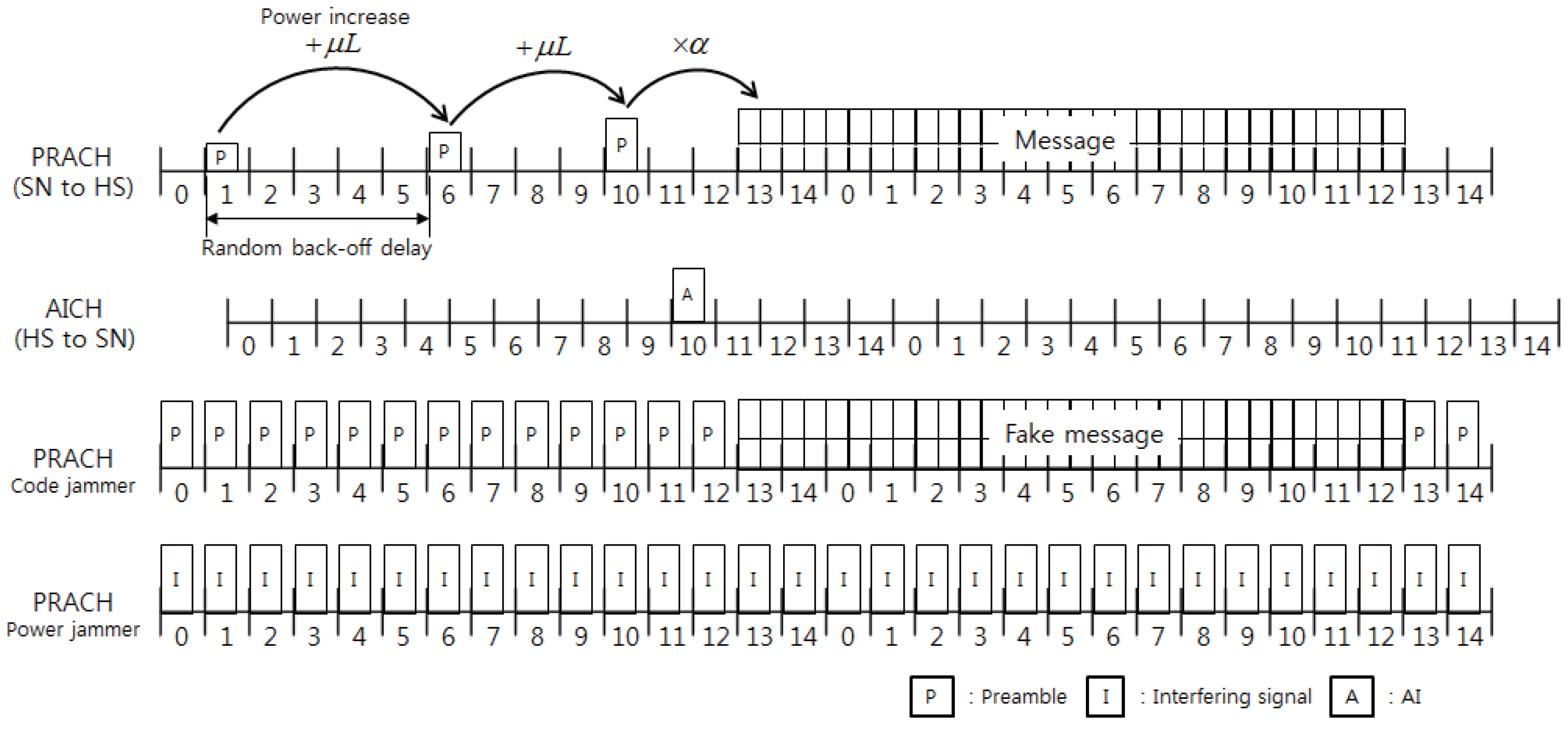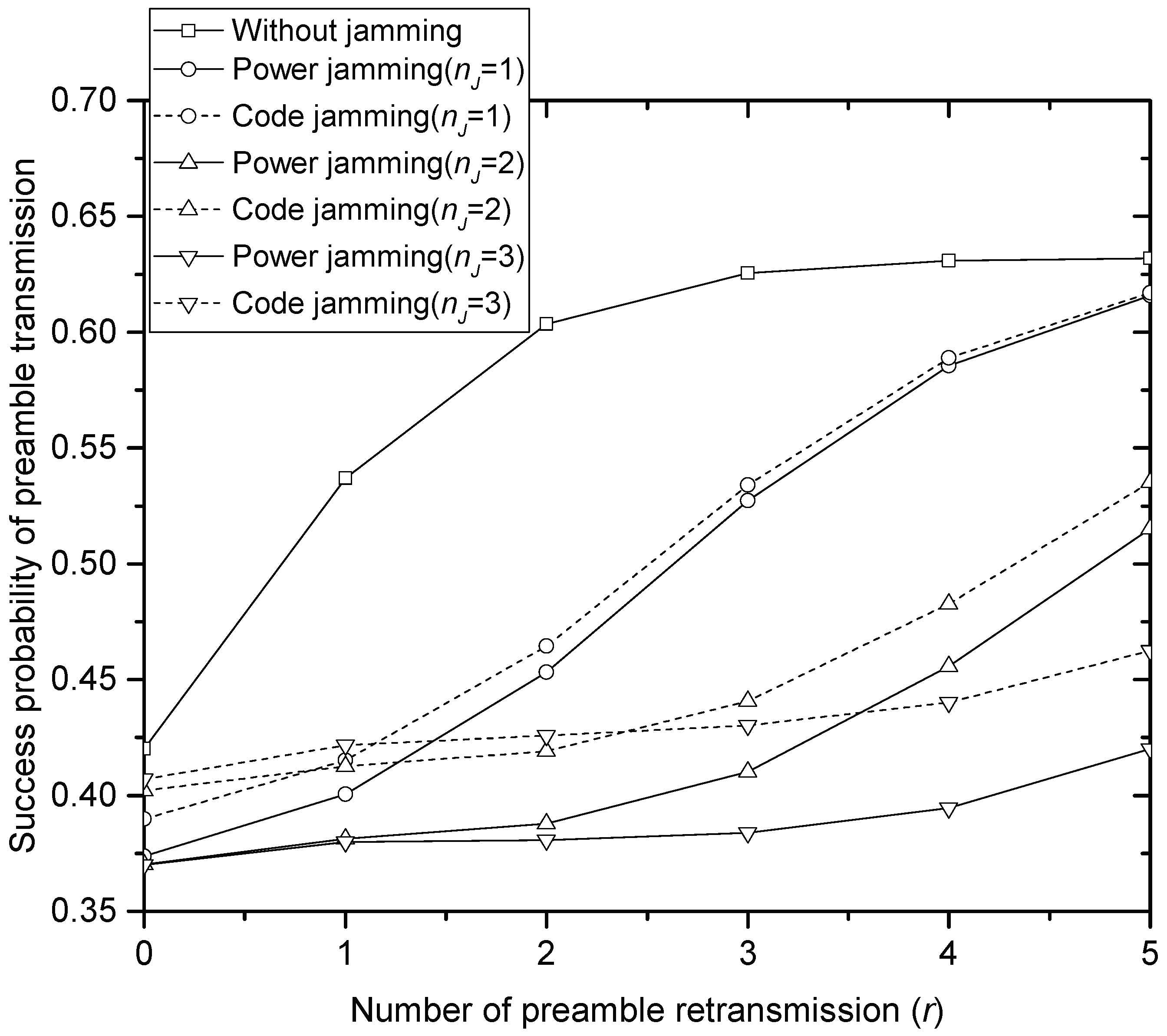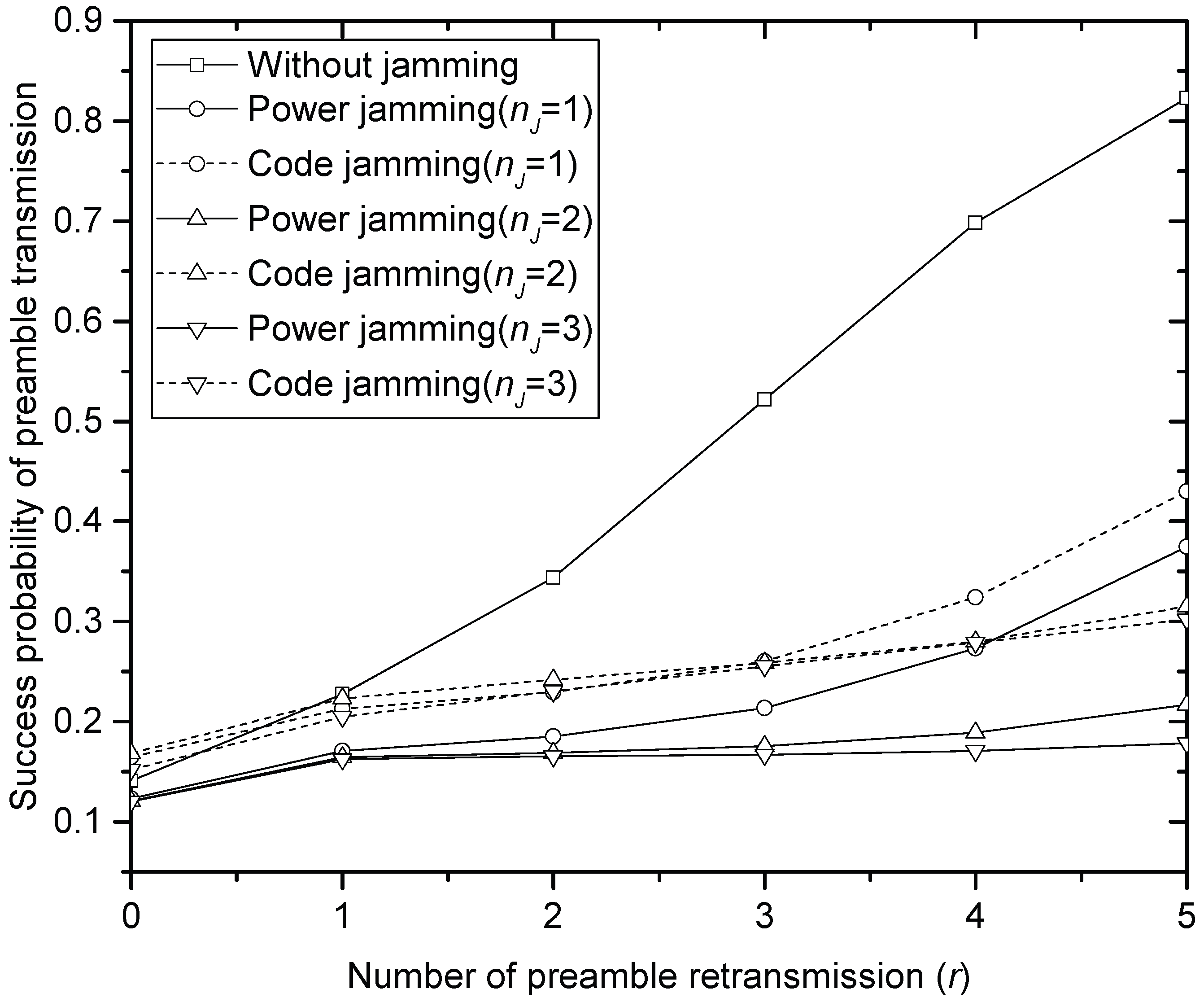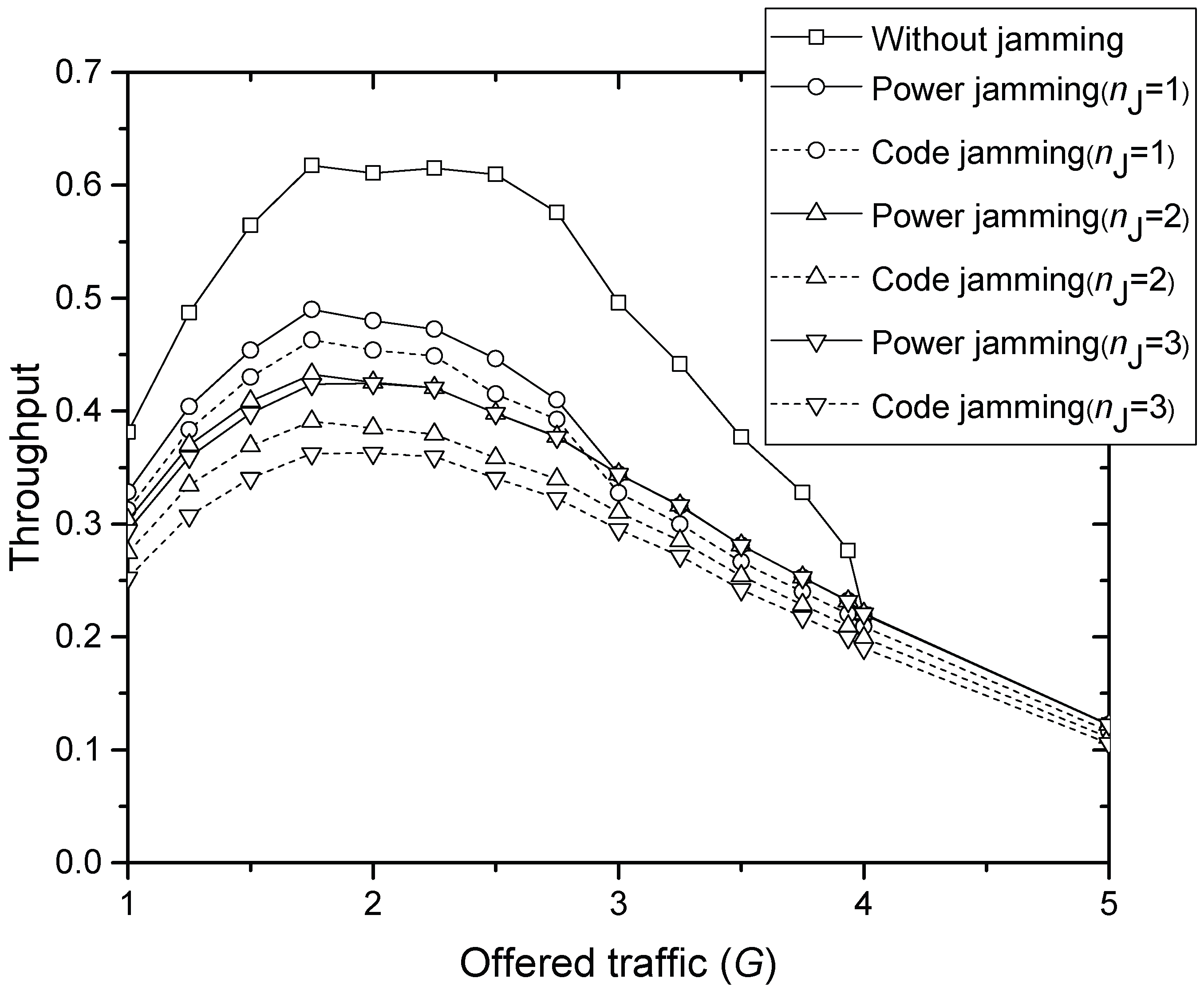Random Access Performance of Distributed Sensors Attacked by Unknown Jammers
Abstract
:1. Introduction
2. System Model
2.1. System Description and RA Procedure
2.1.1. RA Procedure
2.1.2. Jamming Types
2.1.3. Traffic and RF Channel Model
2.2. Power Capture Model for Preamble Transmission
2.3. Power Capture Model for Message Transmission
2.4. Power Ramping for Preamble Transmission and Message Transmission
3. RA Performance Analysis
3.1. Success Probability of Preamble Transmission
3.1.1. Success Probability of r-th Preamble Retransmission
3.1.2. Derivation of
3.2. Throughput of Random Access Request
3.3. Access Delay of Random Access Request
4. Numerical Results
5. Conclusions
Acknowledgments
Author Contributions
Conflicts of Interest
Abbreviations
| AI | Indicator of acquisition |
| AICH | AI channel |
| AN | Artificial noise |
| DoS | Denial of service |
| HS | Head sensor |
| LTE | Long-Term Evolution |
| MSG | Frame-long message |
| MT | MSG transmission |
| PRACH | Physical RACH |
| PT | Preamble transmission |
| RA | Random access |
| RACH | RA channel |
| RF | Radio frequency |
| SINR | Signal-to-interference-plus-noise ratio |
| SN | Sensor node |
| SN-A | Anonymous SN |
| TC | Transmission cycle |
| UMTS | Universal Mobile Telecommunication System |
| WCDMA | Wideband Code Division Multiple Access |
| WSN | Wireless sensor network |
Appendix A Derivation of
Appendix B Derivation of
Appendix C Notations
| Notation | Description |
|---|---|
| N | The number of legitimate SNs contending for the same access slot |
| G | Arrival rate of composite PT is modeled by a Poisson process |
| s | The number of available access codes |
| K | The number of SNs selecting the same code in the same time slot |
| L | The number of fingers in a RAKEreceiver |
| Average received power from each path | |
| Received power at each finger | |
| The number of SNs in simultaneous PT | |
| The number of jammers | |
| The number of SNs transmitting MSG | |
| Received power from SN-i transmitting a preamble | |
| Received power from SN-j transmitting MSG | |
| Received power from a hostile jammer | |
| Minimum SINR required for successfully decoding a preamble | |
| Interference plus noise power | |
| q | Probability of successful reception of AI |
| W | The number of SNs that successfully receive AI |
| z | Slot length for MSG transmission |
| t | Time index of the access slots used by delivering MSG |
| The number of SNs transmitting a preamble at access slot t | |
| The number of SNs transmitting MSG at access slot t | |
| w | The number of SNs that receive the same AI with SN-A |
| Probability of safe reception of MSG without collision-outage | |
| Received MSG power at l-th finger from SN-i | |
| Received power from SN-i transmitting a preamble at the t-th access slot | |
| Received power from SN-j transmitting MSG at the t-th access slot | |
| SINR of MSG signals | |
| SINR requirement of MSG signals | |
| Average path power | |
| r | The number of retransmissions |
| Average number of preamble retransmissions | |
| Average jamming power | |
| Maximum power level of jamming signals | |
| Power increment ratio for MSG transmission | |
| Conditional success probability at the r-th preamble transmission | |
| P | State variable for indicating power jamming |
| S | State variable for indicating code jamming |
| Arrival rate of initial PT | |
| Arrival rate of the r-th preamble retransmissions | |
| Throughput of PT | |
| The maximum number of allowable preamble retransmissions | |
| Probability that SN-A receives AI successfully | |
| Probability that a jammer receives AI successfully | |
| Success probability of MT after the successful r-th preamble retransmission | |
| Throughput of PT and MSG transmission | |
| C | The number of restarts of TC |
| Probability that MT is failed | |
| Average delay occurred in PT and receiving AI | |
| Average delay occurred in TC when TC terminates successfully | |
| Average delay occurred in TC when TC terminates with a failure | |
| Total access delay | |
| Definition declaration | |
| Floor function |
References
- Akyildiz, I.F.; Su, W.; Sankarasubramaniam, Y.; Cayirci, E. Wireless Sensor Networks: A Survey. Comput. Netw. 2002, 38, 393–422. [Google Scholar] [CrossRef]
- Xu, W.; Ma, K.; Trappe, W.; Zhang, Y. Jamming Sensor Networks: Attack and Defense Strategies. IEEE Netw. 2006, 20, 41–47. [Google Scholar]
- Shi, E.; Perrig, A. Designing Secure Sensor Networks. Wirel. Commun. Mag. 2004, 11, 38–43. [Google Scholar]
- Wood, A.D.; Stankovic, J.A. Denial of Service in Sensor Networks. Computer 2002, 35, 54–62. [Google Scholar] [CrossRef]
- Xu, W.; Trappe, W.; Zhang, Y.; Wood, T. The Feasibility of Launching and Detecting Jamming Attacks in Wireless Networks. In Proceedings of the 6th ACM International Symposium on Mobile Ad Hoc Networking and Computing, Urbana-Champaign, IL, USA, 25–27 May 2005; pp. 46–57. [Google Scholar]
- Li, M.; Koutsopoulos, I.; Poovendran, R. Optimal Jamming Attack Strategies and Network Defense Policies in Wireless Sensor Netwroks. IEEE Trans. Mob. Comput. 2010, 9, 1119–1133. [Google Scholar]
- Aziz, F.M.; Shamma, J.S.; Stüber, G.L. Resilience of LTE Networks Against Smart Jamming Attacks. In Proceedings of the Global Communications Conference (GLOBECOM), Austin, TX, USA, 8–12 December 2014; pp. 734–737. [Google Scholar]
- Lichtman, M.; Jover, R.P.; Labib, M.; Rao, R.; Marojevic, V.; Reed, J.H. LTE/LTE-A Jamming, Spoofing, and Sniffing: Threat Assessment and Mitigation. IEEE Commun. Mag. 2016, 54, 54–57. [Google Scholar] [CrossRef]
- Del-Valle-Soto, C.; Mex-perera, C.; Monroy, R.; Nulazo-flores, J.A. On Routing Protocol Influence on the Resilience of Wireless Sensor Networks to jamming attacks. Sensors 2015, 15, 7619–7649. [Google Scholar] [CrossRef] [PubMed]
- Li, X.; Dai, H.-N.; Wang, H.; Xiao, H. On Performance Snalysis of Protective Jamming Schemes in Wireless Sensor Networks. Sensors 2016, 16, 1987. [Google Scholar] [CrossRef] [PubMed]
- Han, Z.; Marina, N.; Debbah, M.; Hjørungnes, A. Physical Layer Security Game: Interaction Between Source, Eavesdropper, and Friendly Jammer. EURASIP J. Wirel. Commun. Netw. 2009, 2009. [Google Scholar] [CrossRef]
- Vilela, J.P.; Bloch, M.; Barros, J.; McLaughlin, S.W. Wireless Secrecy Regions with Friendly Jamming. IEEE Trans. Inf. Forensics Secur. 2011, 6, 256–266. [Google Scholar] [CrossRef]
- Yang, M.; Zhang, B.; Huang, Y.; Yang, N.; Guo, D.; Gao, B. Secure Multiuser Communications in Wireless Sensor Networks with TAS and Cooperative Jamming. Sensors 2016, 16, 1908. [Google Scholar] [CrossRef] [PubMed]
- Li, Z.; Jing, T.; Ma, L.; Huo, Y.; Qian, J. Worst-Case Cooperative Jamming for Secure Communications in CIoT Networks. Sensors 2016, 16, 339. [Google Scholar] [CrossRef] [PubMed]
- ZigBee Alliance. Available online: http://www.zigbee.org (accessed on 13 November 2017).
- Gutierrez, J.A.; Callaway, E.H.; Barrett, R. IEEE 802.15.4 Low-Rate Wireless Personal Area Networks; Institute of Electrical and Electronics Engineers (IEEE): Piscataway, NJ, USA, 2003; ISBN 0-7381-3677-5 SS95127. [Google Scholar]
- 3GPP TS 25.211 (V6.10.0). Physical Channels and Mapping of Transport Channels onto Physical Channels (FDD). Technical Specification (Release 6), Technical Specification Group Radio Access Network. 3GPP, 2003. Available online: http://www.qtc.jp/3GPP/Specs/25211-6a0.pdf (accessed on 13 November 2017).
- Labib, M.; Marojevic, V.; Reed, J. Analyzing and Enhancing the Resilience of LTE/LTE-A Systems to RF Spoofing. In Proceedings of the IEEE Conference Standards for Communications and Networking, Tokyo, Japan, 28–30 October 2015; pp. 315–320. [Google Scholar]
- 3GPP TS 25.214 (V6.5.0). Physical Layer Procedures (FDD). Technical Specification (Release 6), Technical Specification Group Radio Access Network. 3GPP, 2003. Available online: http://www.etsi.org/deliver/etsi_ts/125200_125299/125214/06.05.00_60/ts_125214v060500p.pdf (accessed on 13 November 2017).
- Moberg, J.; Löfgren, M.; Karlsson, R.S. Throughput of The WCDMA Random Access Channel. In Proceedings of the IST Mobile Communication Summit, Galway, Ireland, 1–4 October 2000; Available online: https://pdfs.semanticscholar.org/fc05/2fb6eb24b1902b2e7bd7300be11b4c4a33d5.pdf (accessed on 13 November 2017).
- Davis, D.H.; Gronemeyer, S.A. Performance of Slotted ALOHA Random Access with Delay Capture and Randomized Time of Arrival. IEEE Trans. Commun. 1980, COMM-28, 703–710. [Google Scholar] [CrossRef]
- Yang, Y.; Yum, T.-S.P. Analysis of Power Ramping Schemes for UTRA-FDD Random Access Channel. IEEE Trans. Wirel. Commun. 2005, 4, 2688–2693. [Google Scholar] [CrossRef]
- Curiac, D.-I. Wireless Sensor Network Security Enhancement Using Directional Antennas: State of the Art and Research Challenges. Sensors 2016, 16, 488. [Google Scholar] [CrossRef] [PubMed]
- David, H.A. Order Statistics, 2nd ed.; Wiley: Hoboken, NJ, USA, 1981. [Google Scholar]






| Parameter | Value |
|---|---|
| The number of resolvable paths | |
| Average received power from one path | |
| Interference plus noise power | |
| Minimum SINR for correct preamble reception | dB |
| Power increment ratio for message transmission | |
| Minimum SINR for correct message reception | dB |
| Maximum number of preamble retransmission | |
| The number of available access codes | |
| Probability of successfully receiving AI by an SN or a jammer | |
| Average delay in reception of AI after successful PT | |
| Slot length in message transmission |
© 2017 by the authors. Licensee MDPI, Basel, Switzerland. This article is an open access article distributed under the terms and conditions of the Creative Commons Attribution (CC BY) license (http://creativecommons.org/licenses/by/4.0/).
Share and Cite
Jeong, D.-K.; Wui, J.-H.; Kim, D. Random Access Performance of Distributed Sensors Attacked by Unknown Jammers. Sensors 2017, 17, 2667. https://doi.org/10.3390/s17112667
Jeong D-K, Wui J-H, Kim D. Random Access Performance of Distributed Sensors Attacked by Unknown Jammers. Sensors. 2017; 17(11):2667. https://doi.org/10.3390/s17112667
Chicago/Turabian StyleJeong, Dae-Kyo, Jung-Hwa Wui, and Dongwoo Kim. 2017. "Random Access Performance of Distributed Sensors Attacked by Unknown Jammers" Sensors 17, no. 11: 2667. https://doi.org/10.3390/s17112667
APA StyleJeong, D.-K., Wui, J.-H., & Kim, D. (2017). Random Access Performance of Distributed Sensors Attacked by Unknown Jammers. Sensors, 17(11), 2667. https://doi.org/10.3390/s17112667






